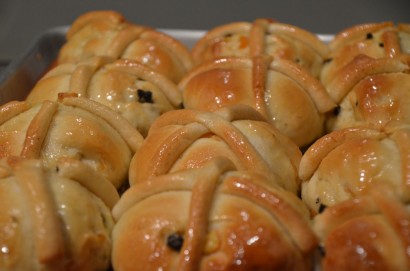No Reviews
You must be logged in to post a review.

These are a bit of work to prepare, but the effort pays off big time with some of the most delicious Easter morning treats you’ve ever had. Marzipan, freshly candied orange peel and a touch of fennel make these extra special occasion buns!
To make the candied orange peel:
Peel the oranges. Set 3 pots full of water over heat and bring to a boil. Blanch the peel by dunking it in a pot of boiling water for 1 minute, 3 separate times, dunking in one pot first, then the second pot, then the third. (This is why you need 3 different pots of boiling water.). This will remove the bitter taste from the peel, and soften the peel so it can better soak up the candying liquid. When done, set the peel aside. Reserve the candying liquid for later.
In yet another pot, combine the sugar and the 2 1/4 cups of water. Cut the vanilla bean open, and scrape the little seeds into the sugar water with a sharp knife. Add the pod to the water, too. Bring this mixture to a boil over high heat. Add the blanched orange peel, and stir until the peels are submerged. Reduce the heat to low, and simmer for 45 minutes to an hour, or until peels are completely soft. Transfer the peel and the liquid to a glass bowl or jar, cover and allow to cool completely for several hours or overnight. You can use them at this time, or keep them indefinitely in the fridge. You will have extra!
To make the buns:
In a large bowl, combine milk, yeast and 1 tablespoon of sugar, whisking until yeast is mostly dissolved. Allow to sit for 5 minutes, until quite foamy. Using your whisk, add the remaining 1/4 cup sugar, and stir to combine. Then add the salt. Stir. Add the fennel seeds. Stir. Add the melted butter. Stir. Whisk in the egg. Stir in the currants and the orange peel. Add the flour, about 1 cup at a time, until the dough is too thick and sticky to use the whisk anymore, and then use your hands to mix in the rest of the flour. If the dough is super sticky and still clinging to to bowl, keep adding flour a few tablespoons at a time, until it is soft and almost smooth.
Transfer dough to another bowl that you’ve coated with cooking spray or oil, cover tightly with plastic wrap, and allow dough to rise until doubled in size, about 2 hours in a warm spot (or overnight in a cool kitchen, if you prefer to bake these in the morning).
While the dough is rising, form crosses out of the almond paste. To do this, divide the paste into 4 pieces, and use your hands to roll each piece out into a long, thin rope about 18 inches long. Using a sharp knife, cut each rope into six 3 inch pieces, so you have 24 segments total. Form 12 crosses by pressing two segments together in the center. Set the crosses aside, covered with a slightly damp cloth so the paste doesn’t dry out while you form the buns.
Turn the puffed up dough out onto a lightly floured surface (it will collapse), and knead gently a few times. Divide into 12 roughly equal-sized portions, and form into rounded balls. Place onto a baking sheet that you’ve covered with parchment paper or a Silpat, so the buns are a little less than an inch apart. Press a cross on top of each bun, using your hands to secure them snugly. Cover the buns with a slightly damp cloth and allow to rise in a warm spot for another 30 minutes or so. Preheat the oven to 350 F.
Once the rolls have risen, put them into the preheated oven and bake for 20-25 minutes, until golden brown.
While the buns are baking, combine all of the glaze ingredients in a small saucepan, and bring to a boil. Immediately remove from the heat and set aside. When the buns come out of the oven, baste them generously with the glaze, going over each bun several times until most of the glaze is used up.
Allow to cool completely, then serve.
Adapted from a recipe on the Good Food blog.
No Comments
Leave a Comment!
You must be logged in to post a comment.